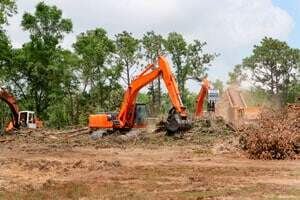 Once upon a time it was possible. Once upon a time, a landowner – whether a small suburban household owner, or a larger scale landowner on rural acreage – had the right to more or less do as he/she pleased on owned land. But the issue of lad clearing in the global warming era is no longer that simple. As governments, corporations and the international community become more aware of global warming and the need for trees to capture and store carbon, so too does the need to police and oversee what we actually carry out on our land.
Once upon a time it was possible. Once upon a time, a landowner – whether a small suburban household owner, or a larger scale landowner on rural acreage – had the right to more or less do as he/she pleased on owned land. But the issue of lad clearing in the global warming era is no longer that simple. As governments, corporations and the international community become more aware of global warming and the need for trees to capture and store carbon, so too does the need to police and oversee what we actually carry out on our land.
The Queensland Department of Environmental Management currently states that “the clearing of native vegetation is regulated by the Vegetation Management Act 199. This Act sets down the rules and regulations that guide what clearing can be done, and how it must be done to meet the requirements of the law.”[1] Various vegetation guidelines and clearing guidelines exist and landholders are also required to apply for permits in many instances to safeguard against illegal clearing and stripping of the land.
Stiff Penalties
The area of Longreach in Queensland has been the site of a recent legal battle over land clearing. This case has impacted notions of individual property rights and ownership and has called into question what it actually means to “own” land in the current environmental climate.
Between 2004-2008 landowning couple Walter and Annette Cooper systematically cleared approximately 431 hectares of vegetation from their land at their property at Tanamera, west of Longreach. They did so without a permit. Some sources have stated “the couple were using the cleared vegetation to feed stock during the drought.”[2] They were recently fined $50,000 and were also ordered to “pay more than $28,000 in costs to the Department of Environment and Resource Management.”[3] This brings the total fine amount to close to $80,000.
Rachel Nolan, Qld Minister for Natural Resources has said that “the Qld Government introduced tough new vegetation management laws to protect endangered wildlife and ensure important vegetation is protected.” She also maintains that “the scientists assessing the areas found the clearing could impact on flora including landscape fragmentation, loss of habitat and possibly lead to the introduction and spread of exotic plant and animal species.”[4]
The clearing was not reported at the time and the landowners did not follow the legal chain of command required in Queensland for land clearing. They did not apply for permits or contact the Department of Environment and Resource Management. Rather, the cleared land was discovered through a routine assessment of satellite imagery by the Queensland Governments Statewide Landcover and Trees Study.
Independent Federal MP Bob Katter has gone on record to state the fine amount is excessive and ludicrous.
Given the current global environmental crisis, Envirosafe Solutions understands and supports the need for tighter government regulation regarding deforestation and land clearing. Envirosafe Solutions is at the forefront of driving industry and business change regarding green procedures and processes.
Join The Green Revolution. Purchase Envirosafe Solutions eco-friendly products. Call them now on 1300 889070.
[1] http://www.derm.qld.giv.au/vegetation/clearing/index.html
[2] http://www.abc.net.au/news/2011-08-04/couple-cop-50k-land-clearing-fine/2823890
[3] Ibid
[4] http://www.cabinet.qld.gov.au/mms/StatementDisplaySingle.aspx?id=75936





















